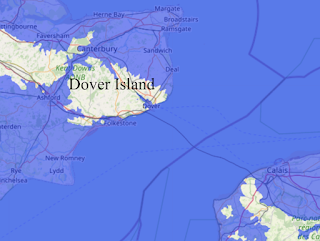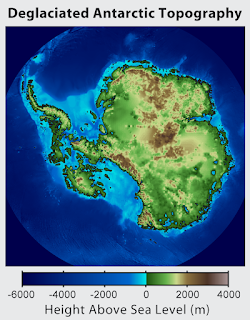Crocodiles on land!
It seems to me like crocodiles will be one of the biggest winners of global warming, and are likely to move into new areas, and one big new area they could move onto would be dry land. It seems as if after every mass extinction there is some form of crocodile that moves to chase prey on dry land. I predict this happening in two new places: Australia's Northern Territory, and in the American Deep South.
In The United States
Ambushes on dry land
It may seem strange to suppose that a crocodile would take over the land when other species of large carnivore, both native and invasive, could take over this role. This is especially the case with the role of a large land-based ambush predator. For instance, the south already has a large ambush predator: the mountain lion, which lives in Florida. However, though the cougar will expand into more northern areas without humans there to keep it confined, it would also find it difficult to blend into the abundant green kudzu. In fact, no mammalian predator would be able to take advantage of the kudzu for camoflage. This is due to physiological issues for mammals. Thus a reptile or bird would fill the niche.
This requirement of a bird or reptile gives a few candidates, and it is the American Alligator which will come out on top because it has a range that overlaps with kudzu already, and while Florida does have invasive monitor lizards that could take up the same niche and while monitor lizards might be even better suited than crocodiles, these tend to be found in Southern Florida, and have smaller jaws and are likely to take roles of smaller ambush predators in kudzu-dense regions, outcompeting coyotes due to having superior camoflage.
Adaptations
The color of these alligators, one of which I will call Vitesuchus xeros, will have a lighter coloration so as to blend into the plentiful kudzu across the deep south. Its teeth also become flatter like those of Boverisuchus, and its forelimbs became more adapted for leaping and grabbing prey with its bite. Of course, xeros not relying on its claws to catch prey means they could be repurposed for locomotion. However, I would doubt that these would become hooves, since bursts of speed would be more crucial than a high top speed, and by being camoflaged to blend into kudzu, Vitesuchus xeros is definitely taking up the role of ambush predator.
Its teeth could end up becoming longer and more adapted to both killing and ripping off chunks of flesh. Generally, here I would suspect the teeth of the front of its mouth would become different from those at the back, but this doesn't occur because alligators do not have differentiated dentition becaue that is a trait exclusive to mammals. With this in mind, it is likely that one group of Vitesuchids would adapt their front legs. to be used to catch prey.
In general it is quite probable that early on in their development the kudzu gators would develop long claws. This would be after they first properly move onto land, and the species evolved from V. xeros, Vitesuchus longonyx, would be characterised by using its longer claws for increased traction in the dense kudzu. The split in the vitesuchids between the claw catchers (beginning with Thanasimonyx) and those that use their teeth to hunt is intitally defined by the Mississippi river, but with time that changes.
Australia
The Third Hooved Crocs
Because we are talking about the evolution of life in the aftermath of a mass extinction, I feel pressured to make a species that is a hooved crocodile, and Australia seems the best place to do it. One species is Boverisuchus. These crocodiles’ claws evolved into hooves, and I see no reason that a group of australian crocodiles shouldn't venture more into the outback. This would start out with them venturing out of the water and gradually gaining a more upright posture in the Ochetamnicene, with the eventual outcome being the fully upright Stesidrakon, which diversifies and competes with the descendents of cattus, and any other varieties of marsupial that gained such a niche.
By the middle Mellogene, the Stesidrakonids had thoroughly collonised australia and spread out from their traditional vorrephagic niche. Stesidraco okythoos is the fastest and chases down kangaroos. Another Kangaroo predator, Grossosuchus coriaceus relies on hardened scales to block attacks from anything else. G. coriaceus is also a bit more of a generalist.
Sources
https://www.theguardian.com/science/2009/nov/19/galloping-dinosaur-eating-crocodiles
https://www.fieldandstream.com/conservation/saltwater-crocodiles-eat-feral-hogs-australia/
https://www.theguardian.com/notesandqueries/query/0,,-1357,00.html
https://en.wikipedia.org/wiki/American_alligator
https://en.wikipedia.org/wiki/Cougar
https://www.livescience.com/63482-giant-water-monitor-florida.html
https://ennds.org/nile-monitor/
https://www.youtube.com/watch?v=QmdcewIjXi0
https://www.theguardian.com/environment/2022/apr/27/swine-dining-crocodiles-are-thriving-in-the-nt-and-it-could-be-because-of-feral-pigs
https://www.natureworldnews.com/articles/50575/20220427/crocodile-population-thrives-due-to-feral-pigs.htm
https://www.newsweek.com/saltwater-crocodiles-terrestrial-prey-saved-extinction-1701092\https://www.amnh.org/exhibitions/horse/the-evolution-of-horses/on-your-toes#:~:text=Hooves%20and%20long%20legs%20help,many%20horses%20retained%20three%20toes.
https://www.google.com/search?q=alligator+claws&rlz=1C5CHFA_enUS907US922&sxsrf=ALiCzsYvn7czIQkkop8vQ2d_48Tc22Irbw:1663699365872&source=lnms&tbm=isch&sa=X&ved=2ahUKEwi32NyNg6T6AhXKMEQIHYoVDkwQ_AUoAnoECAIQBA&biw=1522&bih=810&dpr=2


Comments
Post a Comment